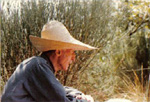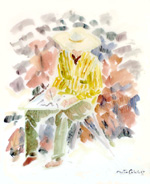

Jean Lombard, the painter
1895 – 1915
Jean Lombard was born in Dijon (France) March 8th 1895 , second son of Georges Lombard and Alice Schulz. The Lombard family, who were protestant, originated from Nîmes.
His mother was of anglo-saxon origin. His grand-father, Henri Lombard, had gone to Valence in Spain to create a silkworm enterprise.
Georges Lombard was sent to Dijon as an engineer for PLM railways; he stayed there for a few years only before going to Lyon.
In 1898 his mother died following the birth of his third brother, Marc. He was brought up along with his three brothers, Pierre, Roger and Marc, by an austere nanny from Alsace and Marie, Roger’s nanny.
Up until 1905 a school teacher came to give them tuition at home.
Jean studied at the Lycée Ampère in Lyon and passed his baccalauréat in 1912.
During his teen years, he often went to “Le Bouquet”, a property by the river Saône belonging to his grand-father Schulz, who welcomed the whole family.
In 1913 Jean started at the “Ecole des Beaux-Arts” in Lyon following in the steps of his great-uncle Charles-François Jalabert (1819-1901). For a long time, Jean used his uncle’s paint brushes and palette.
A retrospective on Jalabert’s work was presented in 1981 in Nîmes.
Jean Lombard studied in the workshop of Auguste Morisot’s who was a draughtsman in the expedition to discover the sources of Orinoco. He also studied with Charles Repelin, whose twin daugthters Germaine and Colette, were also students.
Jean Lombard is counted among the “greats”.
1915-1919
Called up, he left for the front as part of the artillery corps, where his knowledge of maths enabled him to assist in the locating of enemy batteries by their sound. He was then invalided to the auxiliary service.
Once the Armistice was signed, he remained mobilized at the Mont Valérien, but went “awol” to follow Flameng’s classes at the Ecole des Beaux-Arts in Paris.
1920-1930
He reunited with Germaine Repelin, known as Pussy, daughter of his mentor in Lyon. They both graduated to become art teachers in Paris and married at the Notre-Dame-des-Champs in Paris in July 1921. His family was absent, his grand-father Schulz, a minister, being hostile to Jean’s marriage to a catholic. Jean had to promise to bring up his children as catholics. Despite all this he remained very close to his father and his three brothers.
The couple lived at rue Bonaparte in Jean’s workshop.
In 1926, after a short stay at rue Abel Hovelacque, he moved to 24 rue Denfert Rochereau (now rue Heni Barbusse) close to the Val-de-Grâce. His son Jean-Blaise, was born that September.
During the 1920’s, Jean Lombard travelled widely: the Varoise Cost at Sanary, where he stayed with his cousins, the Tempiers; to his sister in law Mag in Kabylie; and to Brittany to visit his brother Pierre and his family.
From 1930, he visited his in-law’s property more frequently, at Valcros in the Roustan countryside, near Aix en Provence.
In Paris, the acquisition of a motorcar enabled him to visit the Vauhalan village regularly in order to paint “sur le motif”, with his friend Bertrand Py.
1931-1939
His daughter Marion was born in November 1932.
In 1934 he moved to 6 avenue Paul Appell, in a Paris council flat.
During this pre-war period he met the writer Gabriel Audisio and the philosopher Camille Schuwer with whom he stayed very close. He was also re-acquainted with Edme Lex, a decorator, and ex-friend from Les Beaux-Arts in Lyon. He also befriended Charpin, a comedian who often came to visit them in Valcros.
Thanks to Gabriel Audisio he met Henri-Paul Eydoux, author of many works on archeology.
During these years he and Pussy travelled to Spain and Italy with their friend Albert Jarrach, printer, editor and collector of antiques.
His father died in Lyon in 1936.
Following his teaching activity towards the end of the 1930’s, he moved some of his classes to the evening, in order to be able to paint during the day.
1939-1945
At the beginning of the war, the family found refuge in Epône, near Mantes la Jolie, then moved to Brittany and the south-west.
Back in Paris in September 1940, he mostly painted family scenes.
At this time, his evening drawing classes were replaced for electrical economy reasons, by painting classes on Saturday afternoon and Sunday morning in a primary school in rue du Vert-Bois, where he created l’Atelier du Vert-Bois. Around this workshop “Le groupe du Vert-bois” formed. This workshop was later attended by Maxime Adam-Tessier , a sculptor who became his brother-in-law and friend. They had met a few years earlier via a common friend, Doctor Chevalier.
Deprived of his stays in Provence, he spent some time at his brother Roger’s property in Morainvilliers; then towards the end of the war at Crillon in Beauvaisis region at his brother-in-law Gabriel Dessus’s property.
In 1942, his brother Roger died.
From 1945, he returned to Valcros.
1945-1958
During these years many friends visited them at Valcros : painters Jean Bazaine, Léon Zack and Félix Aublet ; and lithographers Jacques Ernotte and Pierre de Laboulaye. He and his friend Colville often went painting in the Aixoise countryside. Other people would come to Valcros such as Doctor Chevalier, l’abbé Morel, the writter Georges Duthuit, Sandberg, Director of the Modern Art Museum of Amsterdam, Jean Langevin and his wife Vige, with whom Jean Lombard published a book on teams of children’s drawing (cf. Bibliographie)
In 1952, with his family and Henri-Paul Eydoux, he travelled to northern Spain to visit Roman churches.
Following a trip to Italy with Camille Schuwer (who married the widow of his brother Roger), Jean Lombard painted a fresco of their property, Issambres.
In 1958, he retired from teaching which enables him to dedicate more time to travel and painting.
In 1959, Manuel Rosenthal, whom he had met through his son-in-law, came to spend a few days in Valcros together with his wife and their son Clément. He conducted "Bœuf sur le toit" at the Aix festival, which was the occasion where Jean Lombard made drawings of the orchestra.
1960 - 1970
In the early 60’s, with Pussy, he visited Greece, Crete, Egypt; and Sicily in 1963. They were often accompanied by Henri-Paul Eydoux and his wife. From this period and almost to the end of his life, he spent from June to October at his property near Aix close to his favorite subjects.
In 1964 his brother Marc died.
During these years, known as the “Baroque” era, his paintings were lively, romantic, and impregnated with sensuality.
1971 - 1983
Jean Lombard and his wife celebrated their golden jubilee in 1971, in their property in Provence where an ecumenical office brought together the two sides of the family, both protestant and catholic. This ceremony had a great impact on Jean Lombard, and from then onward his paintings expressed a luminous serenity.
In 1975, he went to Montauban where there was a first retrospective of his work – a tribute to him in the Ingres Museum.
His brother Pierre died in 1980.
He spent his last summer in Valcros in 1982 and died in Paris on October 26th 1983.
He now rests in the vault of the Repelin family in the Ecully cemetery , near Lyon.
